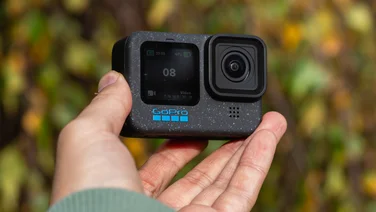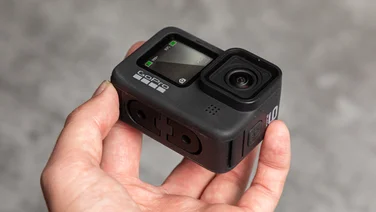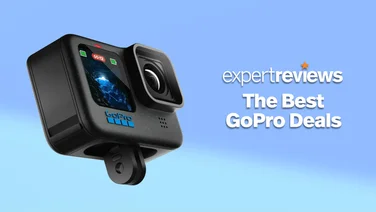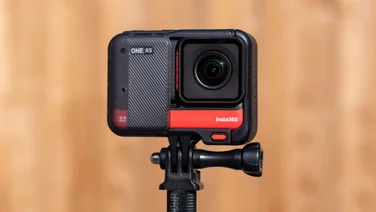To help us provide you with free impartial advice, we may earn a commission if you buy through links on our site. Learn more

Wearable ‘life-logging’ cameras aren’t new. The Autographer was probably one of the more famous attempts at capturing people’s day-to-day lives, but its high price meant it was rather prohibitive to the average consumer. Then there was also the 4GEE Capture Cam, which was arguably one of the worst life-logging cameras I’ve ever tested.
However, life-logging cams shouldn’t be confused with GoPro-like action cams, as these ruggerdised cameras are designed to capture the more exhilarating aspects of our daily lives, such as extreme sports or your weekly bike ride round the countryside. Life-logging cameras, on the other hand, take a decidedly more mundane approach, capturing those candid, unexpected and serendipitous moments as we go about our days. The Drift Compass is one such camera that’s designed to be worn and forgotten about.
Drift might not be a household name like GoPro, but it has plenty of experience with wearable cameras, having released action cameras such as the Ghost S and Stealth 2. I was very fond of both of these cameras, so it was with a degree of excitement that I set about testing the Compass.
Design and Mounts
Its square, all-black design is pretty inconspicuous and it weighs a featherlight 34g, so you barely even notice you’re wearing it. It comes with a standard clip in the box so you can attach it to a jacket collar in any orientation you please, but it can also be used with a lanyard if you want to dangle it around your neck.
However, when the lens is positioned on the corner, orientating the camera the right up way can become rather difficult, as you don’t have a straight edge for a reference point. This often results in photos and video being shot at a skewed angle, and it also means that you can’t simply place the Compass on a flat surface to capture an image or record footage unless you have it in its clip, as placing it on its side will once again result in some rather off-kilter captures.

Even with the clip attached, it’s hard to find somewhere on your body where it can clip on straight. Wearing the lanyard isn’t a great alternative, either, as the camera tends to swing around or get caught in clothing, which isn’t exactly ideal for capturing your day.
An optional Compass Mount Pack (£25) is available, which includes a case, tripod adaptor, adhesive mount, another clip mount and a silicone magnetic skin case. The latter magnetic case is by far my preferred method of wearing the camera, as the magnets are very strong and make attaching the Compass to your clothing far easier. It really should have been included as standard, as it lets you wear the camera on a much wider variety of clothing – not just those that have a logical place to clip the camera on to. The silicone sleeve also adds a degree of protection, too.

That said, as much as I forgot about wearing it, I’d still get the occasional strange look on public transport or from nearby security guards. That’s the one issue I have with life-logging cameras, as you constantly need to be aware of other people’s privacy. Unless you’re a lot less self-conscious than I am, you’ll probably need to be fairly considerate and selective in where you use it.
Controls and App
There’s not much in the way of physical controls on the Compass. On the bottom corner opposite the lens, there’s a button to turn the camera on and then cycle through video, photo and timelapse modes, and there’s also a button on the side to toggle on Wi-Fi. Otherwise, there’s no actual shutter button to begin capturing.

Instead, you’ll need to double-tap the front to start shooting. Well, that’s the theory, anyway. In reality, I found double-tapping the Compass’ so-called ‘percussion inductive sensor’ could be unreliable and erratic. There’s no audio feedback to let you know the camera is beginning capture, either. Instead, the LED around the front button will flash, which can be quite hard to see in bright sunlight, so you’re never 100% sure you’re recording, which is a problem.
I also had trouble capturing photo selfies, as the Compass wouldn’t recognise my thumb’s double tap. Like the lens placement, I don’t understand why this couldn’t have just been a physical button, as the sensor adds nothing but frustration and uncertainty.
There’s some solace to be found in Drift’s companion app, Drift Life, which is available for both iOS and Android. Once you’ve paired it with the Compass, this gives you a live view of the camera sensor, which helps alleviate some of the issues of not knowing if you have a straight horizon. You can also use the app to change settings and trigger the shutter with more assuredness than the double-tap sensor, but it’s a shame the device isn’t better equipped to do this without the aid of a smartphone.
The app also lets you change the photo and video capture resolution, framerates and timelapse intervals (between 2s up to 60 minutes). Timelapse can be set to either photo or video mode, too, and the video mode will handily create a timelapse footage automatically based on the photos in-camera. This saves you from having to combine them all manually, but I was disappointed that it doesn’t save individual photos alongside the video as well.
^A shortened video timelapse. The Drift Compass managed to last in excess of 12 hours altogether
The Compass supports live-streaming, too, both when it’s connected to Wi-Fi or tethering from your smartphone’s data connection. In principle, it’s a novel idea, but over two weeks of testing I just couldn’t get it to work, even after the Android app was updated multiple times over the same period.

One update completely revamped the interface, but I still didn’t have any luck. I also tried switching to the iOS version of the app, but still found no success after attempting to use both a Wi-Fi connection and a paired device’s mobile data. Either the camera and app wouldn’t respond during setup, or it would never progress beyond telling me the camera was logging into Drift’s broadcasting service. I’ll update this review if I ever get it to work, but right now I’ve had zero luck.
The fact that the Drift Life app’s connection tutorial had both grammatical and spelling errors doesn’t exactly inspire you with confidence, either. The app is otherwise rather basic when it comes to camera control, although there are some rudimentary editing tools available if you want to edit on the move, as well as a basic sharing platform where you can follow other users. I can’t see many people choosing to share their content here, though.
Performance and Battery Life
If the Compass has one redeeming quality, it’s that its battery life is very good. It managed to record 1 hour 43 minutes of 1080p, 30fps video before the battery gave out. Timelapse mode provided an even greater return, as when I set it to capture a photo every minute in Timelapse Video mode, it lasted over 12 hours before dying.

^Photo taken while wearing the clip mount
As for the quality of what was captured by the Compass, this was a decidedly mixed bag. Photos would sometimes suffer from camera shake, even in bright daytime sunlight, and indoor scenarios often resulted in poor, blurry, unusuable shots. This is a shame, as I was expecting better from its f/2.2 aperture lens and its ISO range of 50 to 6400. As a result, unless you spend most of your time outside under favourable lighting conditions, the number of sharp photos is disappointingly low.

Video quality also wasn’t great. Not only is there a lot of noise, but colours are also quite subdued and there’s a general lack of sharpness all-round. Recording video while wearing the Compass is also a non-starter, as there’s no stabilisation, making footage incredibly shaky and nausea-inducing. It’s fine if you pop the Compass on a stable surface or hold it in your hand, but that rather defeats its purpose.
^Video captured while walking is as shaky as expected
Conclusion
As a concept, life-logging cams is definitely an idea I can get behind. I would love a wearable camera for capturing my day, especially one that I can let other people tune in into while on the move. Unfortunately, the Drift Compass has too many issues to make it worth recommending over its rivals.
Not only could I not get the live-streaming to work, but it’s also lacking some basic fundamentals. Triggering it to start capturing is frustrating and the resulting footage was often pretty disappointing. This is a real shame as I would love for life-logging cameras to take off, but the wait continues for a truly excellent alternative to its ruggedised action cam cousins.






